Stratification Effects on Estuarine Mixing: Comparative Analysis of the Danshui Estuary and a Thermal Discharge Outlet
Abstract
:1. Introduction
2. Materials and Methods
2.1. Study Area
2.2. Measuring Method
2.2.1. CTD Measurement
2.2.2. Sea Surface Temperature Measured by Drifter Array
2.2.3. Nutrient Concentration Measurement of Water Samples
3. Results and Analysis
3.1. Analysis of the Stratification Phenomenon in Danshui Estuary
3.2. Upwelling of Cold Water Around the Thermal Discharge Outlet
3.3. The Mixing Process of Nutrients in the Danshui Estuary
3.4. Attenuation Curve of Water Temperature in Thermal Discharge Area
3.5. The Horizontal Dispersion Coefficient Measured Using Sea Surface Drifter Array
3.5.1. Dispersion Coefficient of Danshui Estuary and Thermal Discharge Area
3.5.2. Relationship Between Horizontal Dispersion and the Drifter Array’s Spatial Scale
4. Conclusions
Author Contributions
Funding
Institutional Review Board Statement
Informed Consent Statement
Data Availability Statement
Conflicts of Interest
References
- Grasso, F.; Caillaud, M. A ten-year numerical hindcast of hydrodynamics and sediment dynamics in the Loire Estuary. Sci. Data 2023, 10, 394. [Google Scholar] [CrossRef] [PubMed]
- Dzwonkowski, B.; Kang, X.; Sahoo, B.; Veeramony, J.; Mitchell, S.; Xia, M. Mixing and transport in estuaries and coastal waters a special issue in Estuarine Coastal and Shelf Science. Estuar. Coast. Shelf Sci. 2023, 288, 108370. [Google Scholar] [CrossRef]
- Boyer, E.W.; Howarth, R.W. Nitrogen fluxes from rivers to the coastal oceans. In Nitrogen in the Marine Environment; Elsevier Inc.: Amsterdam, The Netherlands, 2008; pp. 1565–1587. [Google Scholar]
- Vitousek, P.M.; Menge, D.N.; Reed, S.C.; Cleveland, C.C. Biological nitrogen fixation: Rates, patterns and ecological controls in terrestrial ecosystems. Philos. Trans. R. Soc. B Biol. Sci. 2013, 368, 20130119. [Google Scholar] [CrossRef] [PubMed]
- Liu, K.-K.; Yan, W.J.; Lee, H.-J.; Chao, S.-Y.; Gong, G.-C.; Yeh, T.-Y. Impacts of increasing dissolved inorganic nitrogen discharged from Changjiang on primary production and seafloor oxygen demand in the East China Sea from 1970 to 2002. J. Mar. Syst. 2015, 141, 200–217. [Google Scholar] [CrossRef]
- Glavovic, B.; Limburg, K.; Liu, K.-K.; Emeis, K.-C.; Thomas, H.; Kremer, H.; Avril, B.; Zhang, J.; Mulholland, M.R.; Glaser, M.; et al. Living on the Margin in the Anthropocene: Engagement arenas for sustainability research and action at the ocean–land interface. Curr. Opin. Environ. Sustain. 2015, 14, 232–238. [Google Scholar] [CrossRef]
- Diaz, R.J.; Rosenberg, R. Spreading Dead Zones and Consequences for Marine Ecosystems. Science 2008, 321, 926–929. [Google Scholar] [CrossRef]
- Dumont, E.; Harrison, J.A.; Kroeze, C.; Bakker, E.J.; Seitzinger, S.P. Global distribution and sources of dissolved inorganic nitrogen export to the coastal zone: Results from a spatially explicit, global model. Glob. Biogeochem. Cycles 2005, 19, 4. [Google Scholar] [CrossRef]
- Huang, J.-C.; Lee, T.-Y.; Lin, T.-C.; Hein, T.; Lee, L.-C.; Shih, Y.-T.; Kao, S.-J.; Shiah, F.-K.; Lin, N.-H. Effects of different N sources on riverine DIN export and retention in a subtropical high-standing island, Taiwan. Biogeosciences 2016, 13, 1787–1800. [Google Scholar] [CrossRef]
- Rahman, W.; Abedin, M.Z.; Chowdhury, S. Efficiency analysis of nuclear power plants: A comprehensive review. World J. Adv. Res. Rev. 2023, 19, 527–540. [Google Scholar] [CrossRef]
- Huang, J.-C.; Lin, C.-C.; Chan, S.-C.; Lee, T.-Y.; Hsu, S.-C.; Lee, C.-T.; Lin, J.-C. Stream discharge characteristics through urbanization gradient in Danshui River, Taiwan: Perspectives from observation and simulation. Environ. Monit. Assess. 2012, 184, 5689–5703. [Google Scholar] [CrossRef] [PubMed]
- Lee, T.-Y.; Shih, Y.-T.; Huang, J.-C.; Kao, S.-J.; Shiah, F.-K.; Liu, K.-K. Speciation and dynamics of dissolved inorganic nitrogen export in the Danshui River, Taiwan. Biogeosciences 2014, 11, 5307–5321. [Google Scholar] [CrossRef]
- Jan, S.; Chen, C.-T.A.; Tu, Y.-Y.; Tsai, H.-S. Physical Properties of Thermal Plumes from a Nuclear Power Plant in the Southernmost Taiwan. J. Mar. Sci. Technol. 2004, 12, 10. [Google Scholar] [CrossRef]
- Tseng, R.-S. On the Dispersion and Diffusion Near Estuaries and Around Islands. Estuar. Coast. Shelf Sci. 2002, 54, 89–100. [Google Scholar] [CrossRef]
- Manning, J.; Churchill, J. Estimates of dispersion from clustered-drifter deployments on the southern flank of Georges Bank. Deep. Sea Res. Part II Top. Stud. Oceanogr. 2006, 53, 2501–2519. [Google Scholar] [CrossRef]
- Chen, Y.-L.; Hsieh, C.-H. Seasonal variations in phytoplankton community structure in the Danshui River estuary, Taiwan. J. Mar. Syst. 2012, 98, 1–12. [Google Scholar]
- Jan, S.; Chen, C.A. Potential biogeochemical effects from vigorous internal tides generated in Luzon Strait: A case study at the southernmost coast of Taiwan. J. Geophys. Res. Ocean. 2009, 114, 4. [Google Scholar] [CrossRef]
- Gao, L.; Li, D.; Zhang, Y. Nutrients and particulate organic matter discharged by the Changjiang (Yangtze River): Seasonal variations and temporal trends. J. Geophys. Res. Biogeosci. 2012, 117, G04001. [Google Scholar] [CrossRef]
- Raven, J.A.; Taylor, R. Macroalgal growth in nutrient-enriched estuaries: A biogeochemical and evolutionary perspective. Water Air Soil Pollut. Focus 2003, 3, 7–26. [Google Scholar] [CrossRef]
- Mu, J.; Zhang, S.; Liang, C.; Xian, W.; Shen, Z. Temporal and spatial distribution and mixing behavior of nutrients in the Changjiang River Estuary. Mar. Sci. 2020, 44, 19–35. [Google Scholar]
- Marmorino, G.; Savelyev, I.; Smith, G.B. Surface thermal structure in a shallow-water, vertical discharge from a coastal power plant. Environ. Fluid Mech. 2015, 15, 207–229. [Google Scholar] [CrossRef]
- Liu, S.M.; Hong, G.-H.; Zhang, J.; Ye, X.W.; Jiang, X.L. Nutrient budgets for large Chinese estuaries. Biogeosciences 2009, 6, 2245–2263. [Google Scholar] [CrossRef]
- Lu, F.-H.; Ni, H.-G.; Liu, F.; Zeng, E.Y. Occurrence of nutrients in riverine runoff of the Pearl River Delta, South China. J. Hydrol. 2009, 376, 107–115. [Google Scholar] [CrossRef]
- Halpern, B.S.; Ebert, C.M.; Kappel, C.V.; Madin, E.M.; Micheli, F.; Perry, M.; Selkoe, K.A.; Walbridge, S. Global priority areas for incorporating land–sea connections in marine conservation. Conserv. Lett. 2009, 2, 189–196. [Google Scholar] [CrossRef]
- Gu, J.; Zhang, Y.; Tuo, P.; Hu, Z.; Chen, S.; Hu, J. Surface floating objects moving from the Pearl River Estuary to Hainan Island: An observational and model study. J. Mar. Syst. 2024, 241, 103917. [Google Scholar] [CrossRef]
- Wang, C.-F.; Hsu, M.-H.; Kuo, A.Y. Residence time of the Danshuei River estuary, Taiwan. Estuar. Coast. Shelf Sci. 2004, 60, 381–393. [Google Scholar] [CrossRef]
- Suara, K.; Wang, C.; Feng, Y.; Brown, R.J.; Chanson, H.; Borgas, M. High-Resolution GNSS-Tracked Drifter for Studying Surface Dispersion in Shallow Water. J. Atmos. Ocean. Technol. 2015, 32, 579–590. [Google Scholar] [CrossRef]
- Suara, K.; Brown, R.; Borgas, M. Eddy diffusivity: A single dispersion analysis of high resolution drifters in a tidal shallow estuary. Environ. Fluid Mech. 2016, 16, 923–943. [Google Scholar] [CrossRef]
- Monin, A.S.; Yaglom, A.M. Statistical Fluid Mechanics: Mechanics of Turbulence; MIT Press: Cambridge, MA, USA, 1975; Volume 2, pp. 551–567. [Google Scholar]
- Okubo, A. Oceanic diffusion diagrams. Deep. Sea Res. Oceanogr. Abstr. 1971, 18, 789–802. [Google Scholar] [CrossRef]
- Yanagi, T.; Murashita, K.; Higuchi, H. Horizontal turbulent diffusivity in the sea. Deep Sea Res. Part A Oceanogr. Res. Pap. 1982, 29, 217–226. [Google Scholar] [CrossRef]
- Michida, Y.; Tanaka, K.; Komatsu, T.; Ishigami, K.; Nakajima, M. Effects of divergence, convergence, and eddy diffusion upon the transport of objects drifting on the sea surface. Bull. Coast. Oceanogr. 2009, 46, 77–83. [Google Scholar]
- Matsuzaki, Y.; Fujita, I. Horizontal Turbulent Diffusion at Sea Surface for Oil Transport Simulation. Coast. Eng. Proc. 2014, 1, 8. [Google Scholar] [CrossRef]
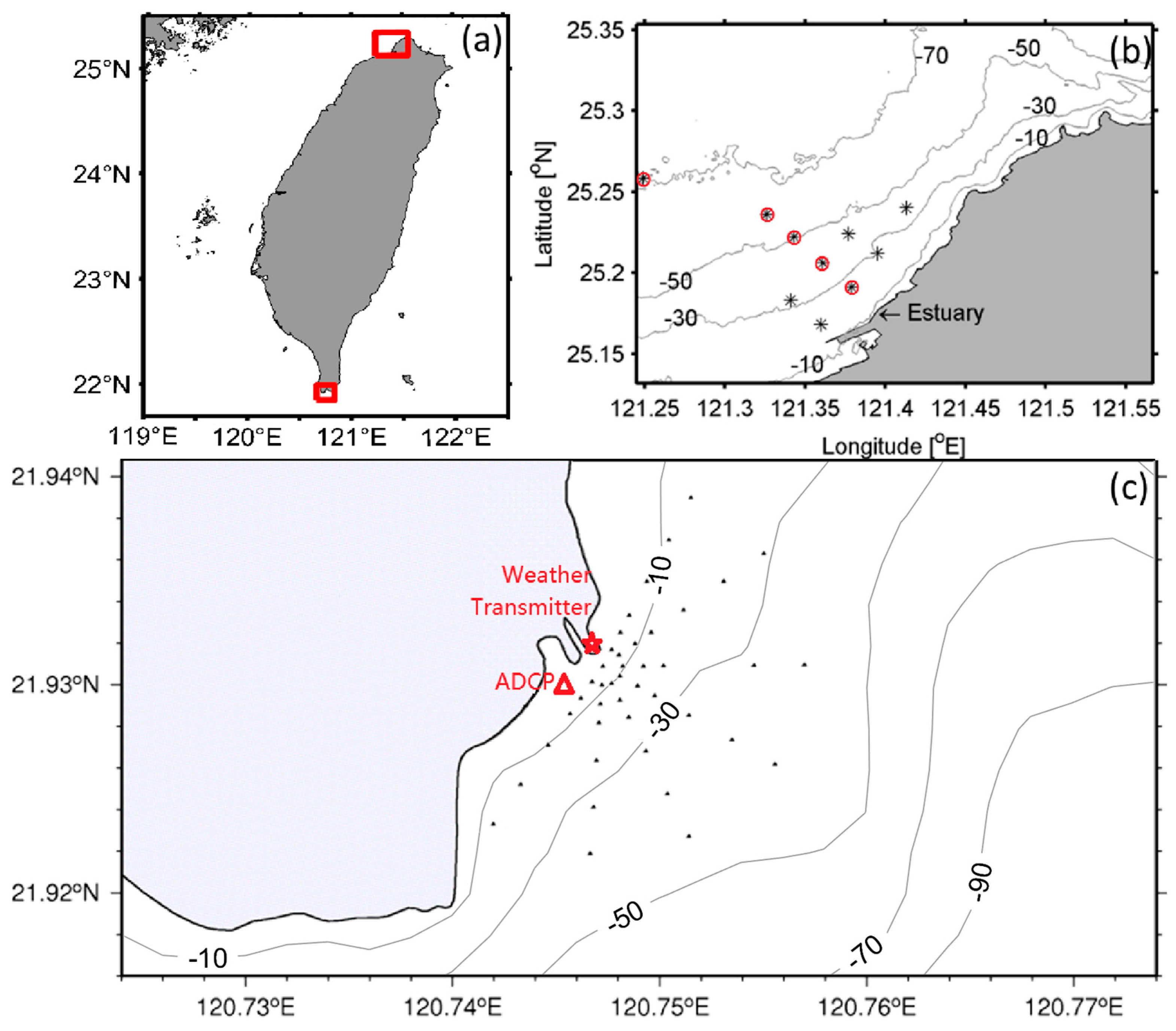
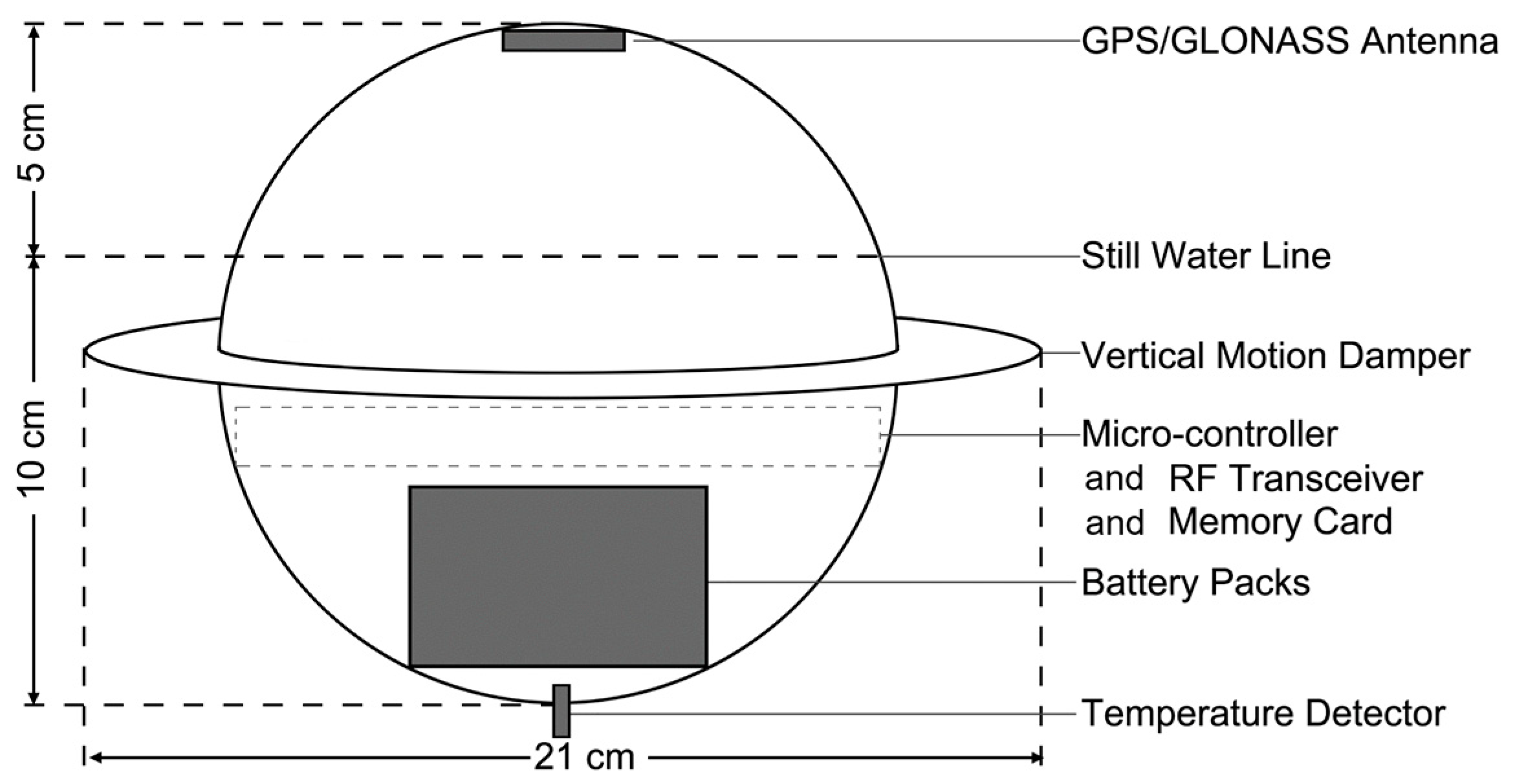
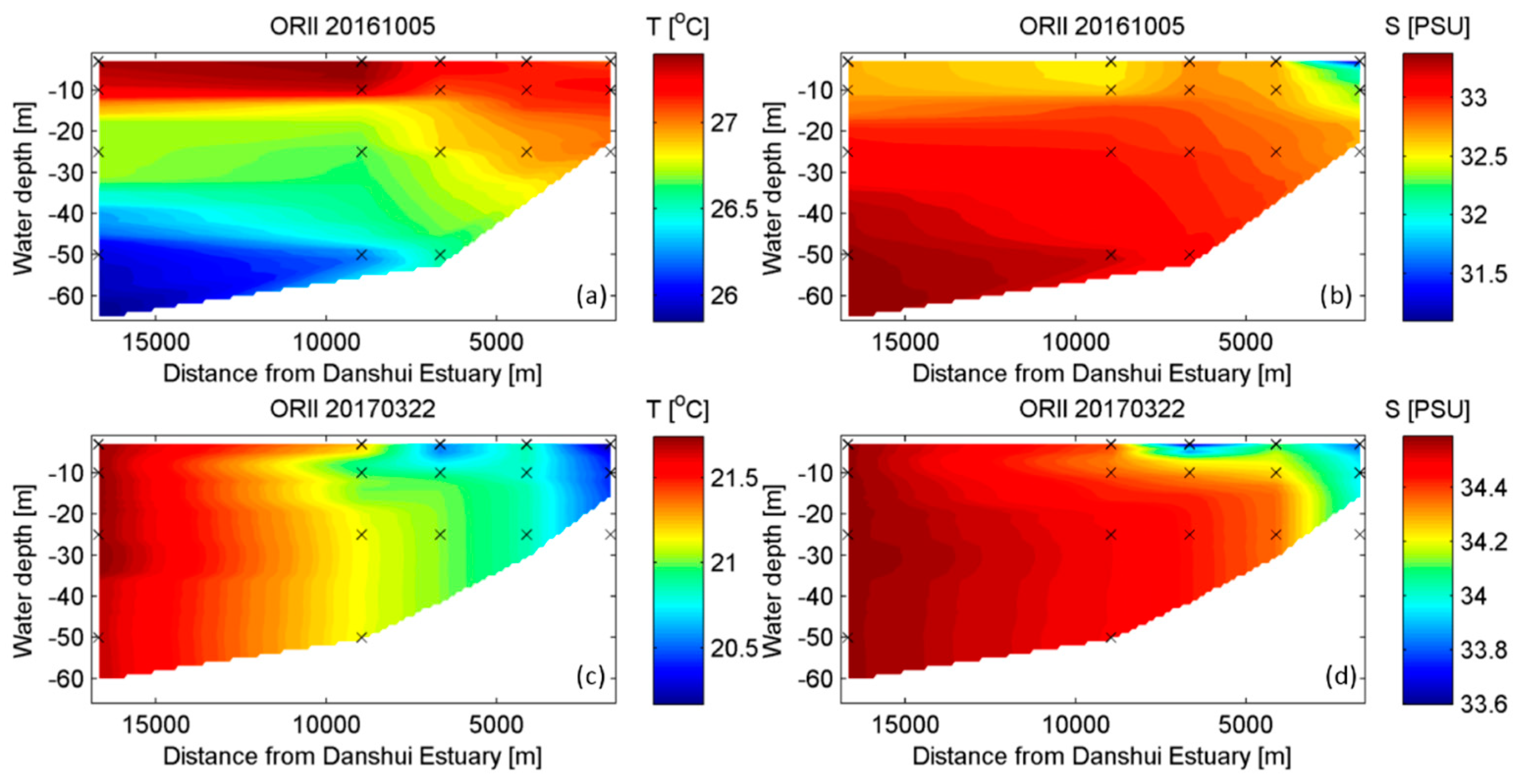
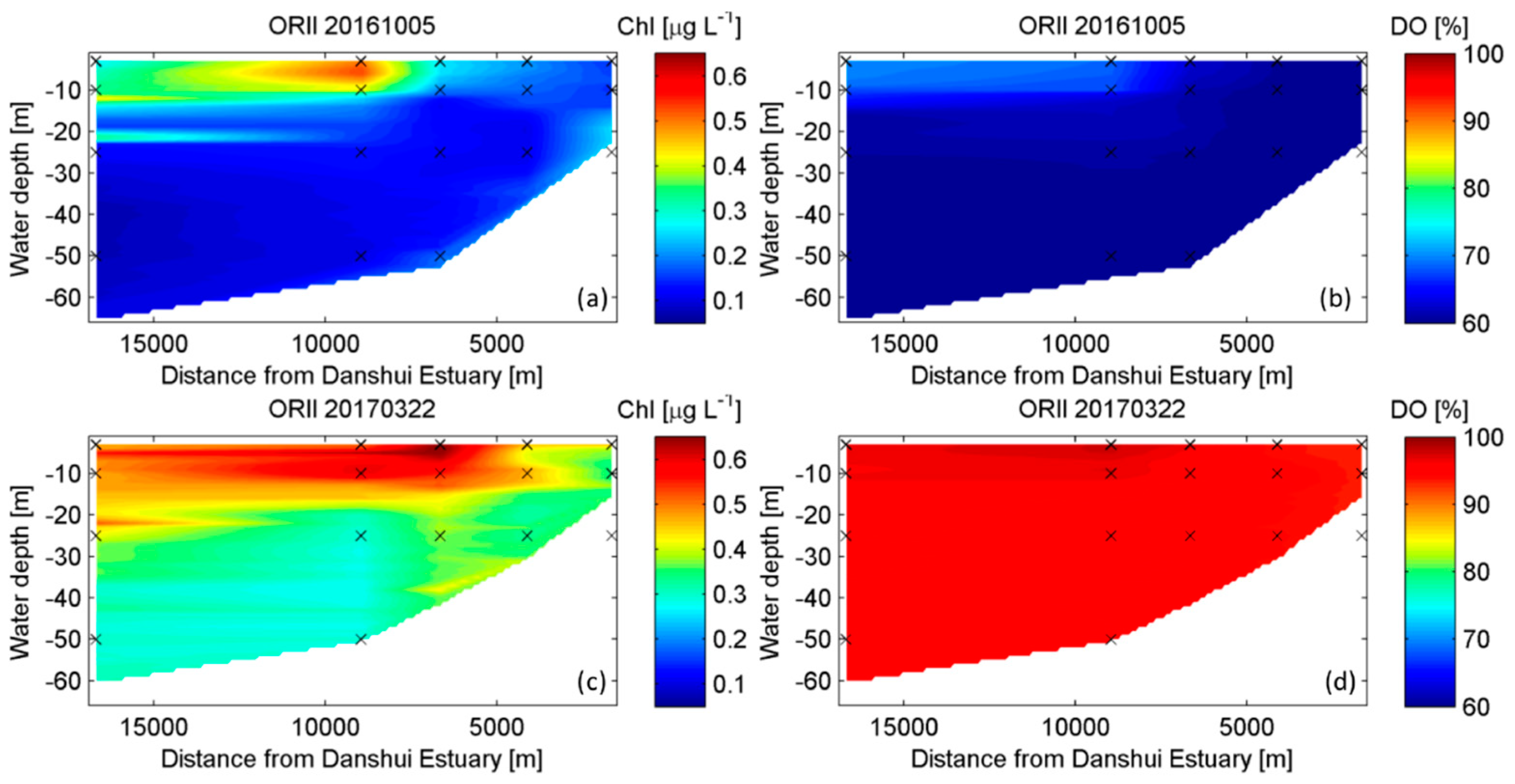
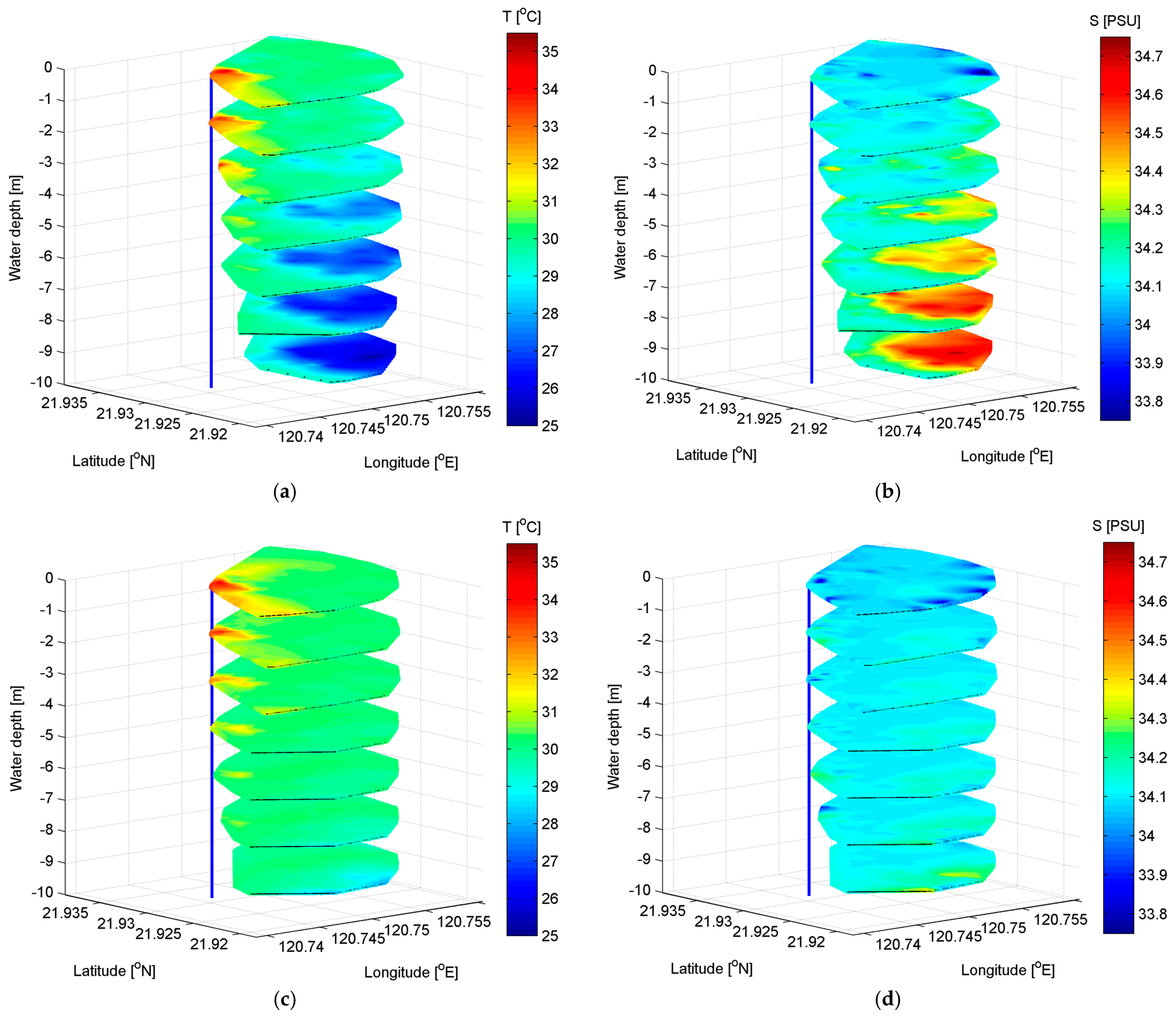
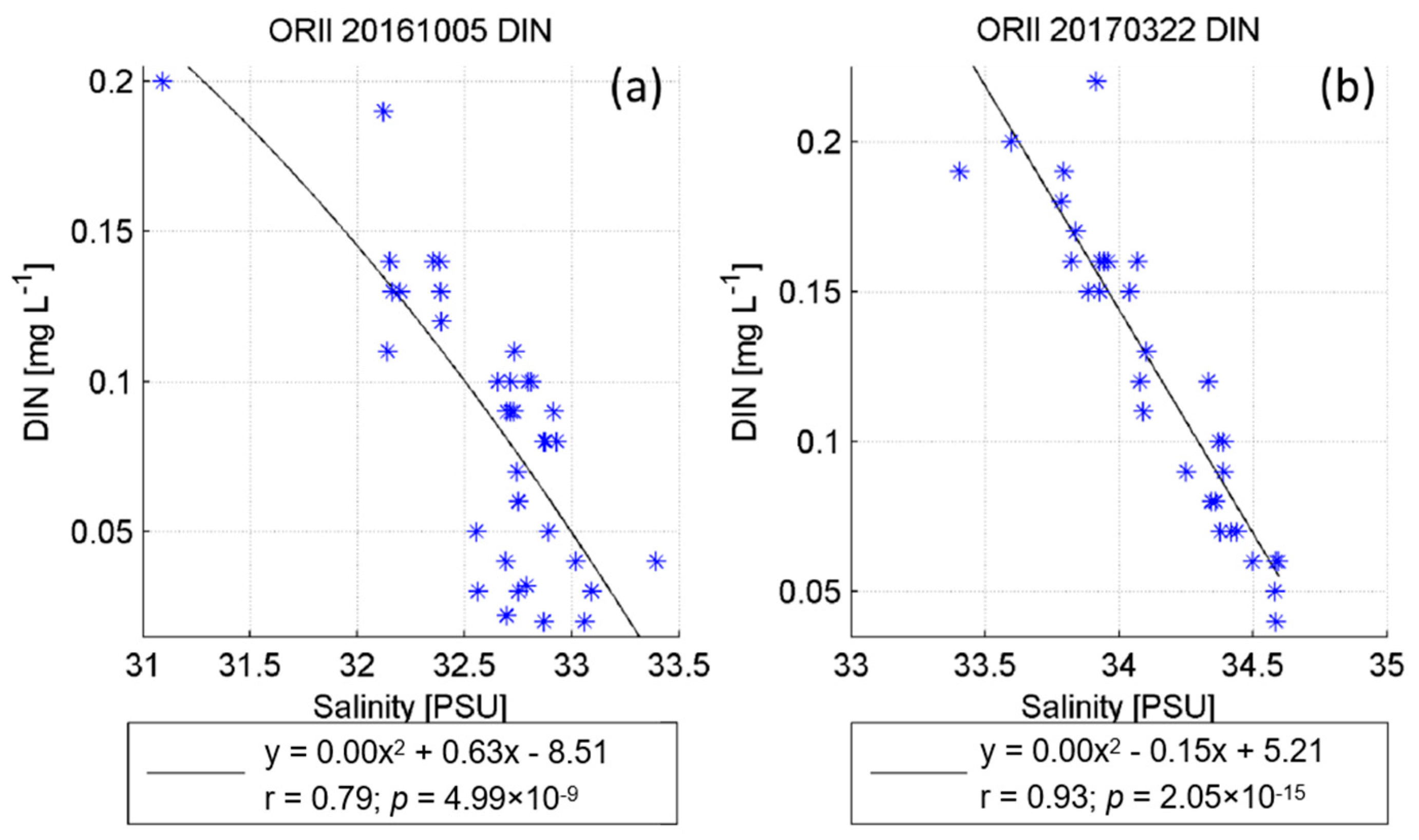
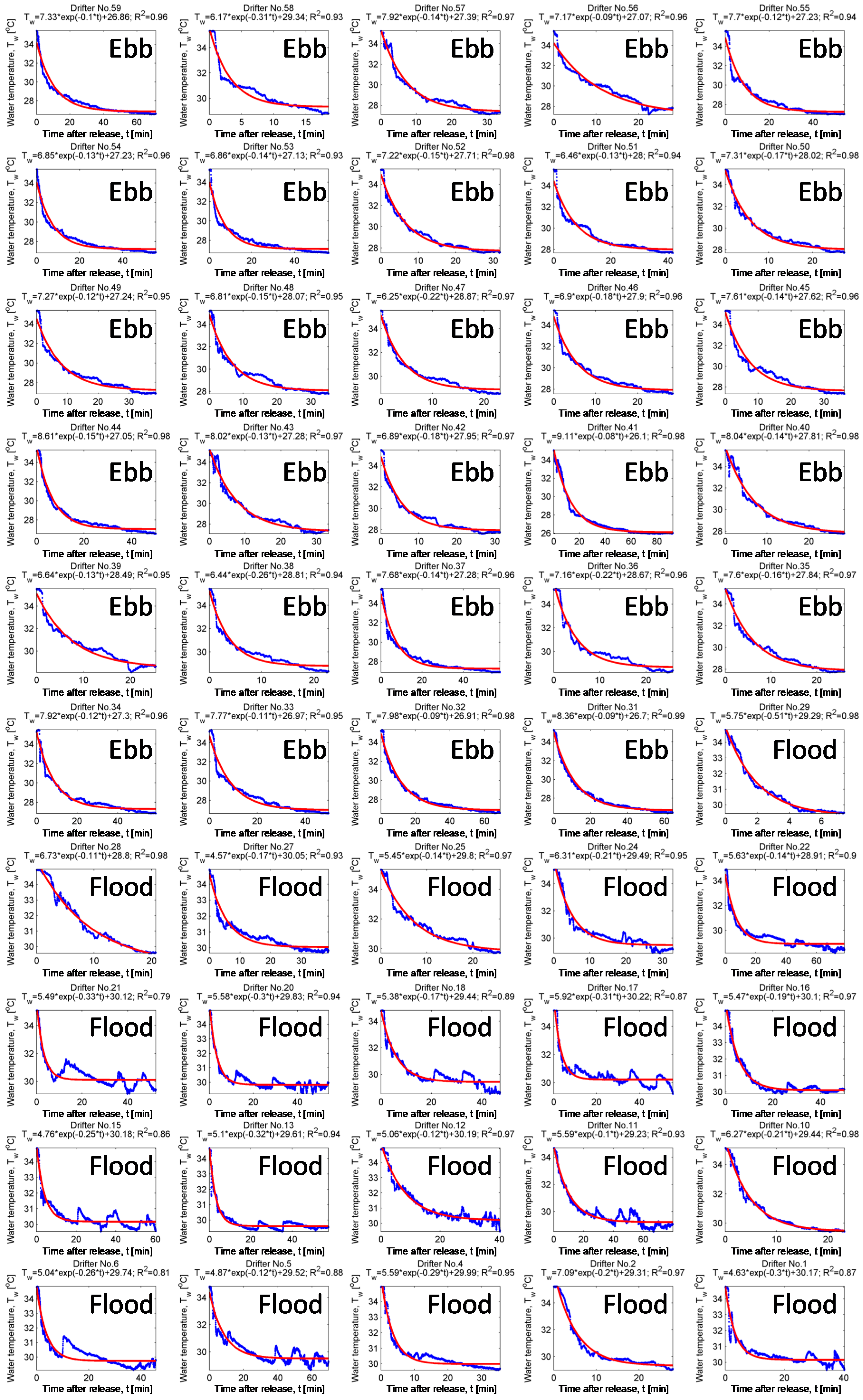
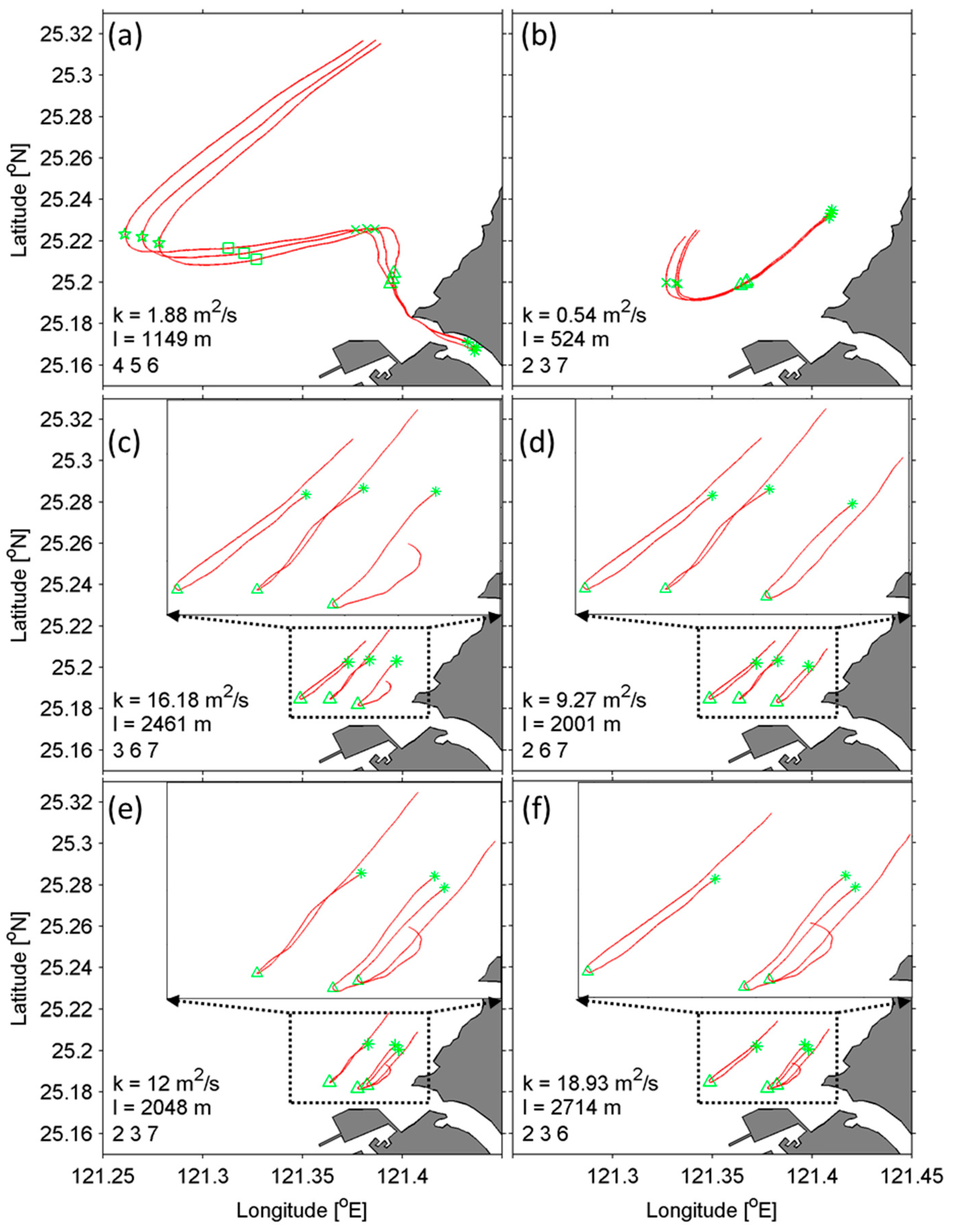
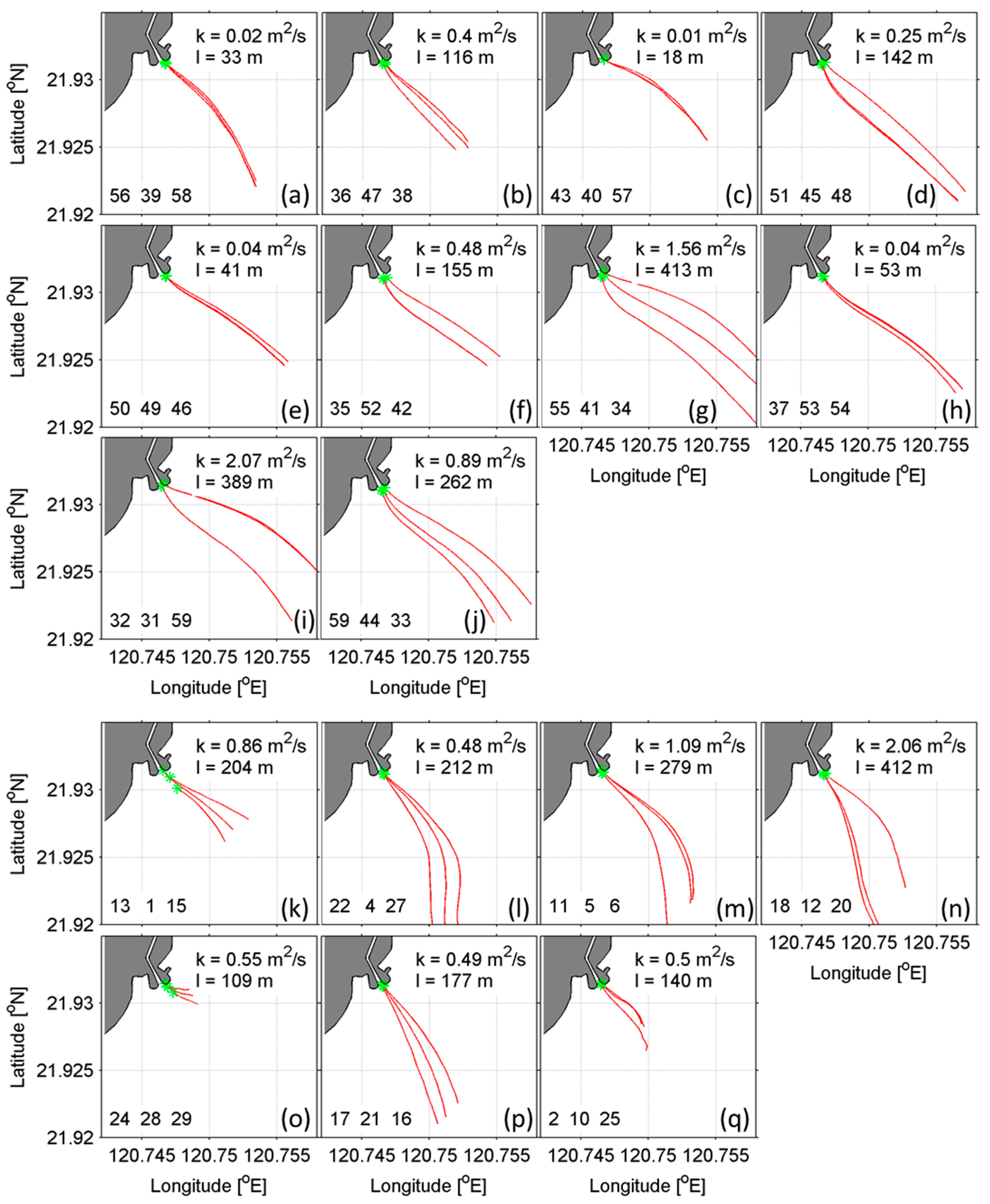

| No.$ | a # | b # | c # | R2 | e-Folding Scale [min] | Tide | No. $ | a | b # | c # | R2 | e-Folding Scale [min] | Tide |
|---|---|---|---|---|---|---|---|---|---|---|---|---|---|
| 4 | 1.72 | −0.4955 | 30.41 | 0.96 | 2.02 | Ebb | 3 | 2.26 | −0.1472 | 29.20 | 0.95 | 6.79 | Flood |
| 12 | 3.30 | −0.6083 | 31.10 | 0.97 | 1.64 | Ebb | 9 | 2.33 | −0.1854 | 31.94 | 0.98 | 5.39 | Flood |
| 15 | 1.57 | −0.4654 | 31.14 | 0.95 | 2.15 | Ebb | 21 | 2.66 | −0.2935 | 31.79 | 0.97 | 3.41 | Flood |
| 36 | 3.48 | −0.4586 | 30.94 | 0.97 | 2.18 | Ebb | 24 | 2.36 | −0.3370 | 31.96 | 0.96 | 2.97 | Flood |
| 37 | 1.45 | −0.4645 | 31.58 | 0.97 | 2.15 | Ebb | 13 | 2.95 | −0.2884 | 30.97 | 0.99 | 3.47 | Flood |
| 38 | 2.32 | −0.4932 | 31.30 | 0.97 | 2.03 | Ebb | 20 | 2.67 | −0.3902 | 31.51 | 0.97 | 2.56 | Flood |
| 39 | 1.24 | −0.4893 | 30.65 | 0.98 | 2.04 | Ebb | 22 | 3.38 | −0.1223 | 29.69 | 0.98 | 8.18 | Flood |
| 40 | 0.99 | −0.3082 | 31.28 | 0.95 | 3.24 | Ebb | 25 | 2.58 | −0.3904 | 31.79 | 0.97 | 2.56 | Flood |
| 47 | 3.24 | −0.4204 | 31.19 | 0.98 | 2.38 | Ebb | |||||||
| 48 | 1.31 | −0.4695 | 31.56 | 0.95 | 2.13 | Ebb | |||||||
| 49 | 1.64 | −0.4851 | 31.93 | 0.98 | 2.06 | Ebb | |||||||
| 51 | 1.70 | −0.4187 | 31.15 | 0.98 | 2.39 | Ebb | |||||||
| 52 | 1.47 | −0.6863 | 31.82 | 0.98 | 1.46 | Ebb | |||||||
| No. | k vs. l | Sources |
|---|---|---|
| 1 | k = 0.000455l4/3 | Danshui Estuary (This study) |
| 2 | k = 0.000609l4/3 | Thermal discharge outlet (This study) |
| 3 | k = 0.000206l1.15 | Okubo [30] |
| 4 | k = 0.000123l1.22 | Yanagi et al. [31] |
| 5 | k = 0.000004l1.92 | Michida et al. [32] |
| 6 | k = 0.000147l4/3 | Matsuzaki and Fujita [33] |
Disclaimer/Publisher’s Note: The statements, opinions and data contained in all publications are solely those of the individual author(s) and contributor(s) and not of MDPI and/or the editor(s). MDPI and/or the editor(s) disclaim responsibility for any injury to people or property resulting from any ideas, methods, instructions or products referred to in the content. |
© 2024 by the authors. Licensee MDPI, Basel, Switzerland. This article is an open access article distributed under the terms and conditions of the Creative Commons Attribution (CC BY) license (https://creativecommons.org/licenses/by/4.0/).
Share and Cite
Zhong, Y.; Chien, H. Stratification Effects on Estuarine Mixing: Comparative Analysis of the Danshui Estuary and a Thermal Discharge Outlet. J. Mar. Sci. Eng. 2024, 12, 2353. https://doi.org/10.3390/jmse12122353
Zhong Y, Chien H. Stratification Effects on Estuarine Mixing: Comparative Analysis of the Danshui Estuary and a Thermal Discharge Outlet. Journal of Marine Science and Engineering. 2024; 12(12):2353. https://doi.org/10.3390/jmse12122353
Chicago/Turabian StyleZhong, Yaozhao, and Hwa Chien. 2024. "Stratification Effects on Estuarine Mixing: Comparative Analysis of the Danshui Estuary and a Thermal Discharge Outlet" Journal of Marine Science and Engineering 12, no. 12: 2353. https://doi.org/10.3390/jmse12122353
APA StyleZhong, Y., & Chien, H. (2024). Stratification Effects on Estuarine Mixing: Comparative Analysis of the Danshui Estuary and a Thermal Discharge Outlet. Journal of Marine Science and Engineering, 12(12), 2353. https://doi.org/10.3390/jmse12122353







